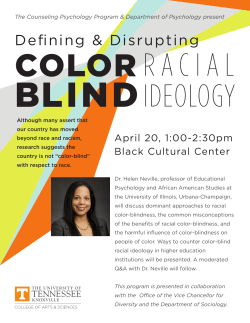
Latin American Concepts of Race
Racial & Ethnic Problems & Challenges in Contemporary Cuba Jorge Duany Florida International University Main Objectives Review racial & ethnic history of Cuba’s population Analyze prevailing racial discourse in Cuba Assess impact of Cuban Revolution on Afro-Cubans Examine continuing racial inequality on the island Compare racial profile of Cuba & its diaspora Race of Cuba’s Population during 19th Century (%) 80 60 40 20 0 1817 1827 1841 1861 1877 1887 1899 White Nonwhite Race of Cuba’s Population since Independence (%) 80 60 40 20 0 1907 White 1931 Black 1953 2002 Mestizo or Mulatto Main Ethnic Groups in Cuba Spanish Andalusian, Canary Islander, Galician, Asturian African Yoruba, Bantu, Arará, Carabalí Asian Chinese Other Haitian, Jamaican, Middle Eastern, Jewish Decimation of Indigenous Population African Slavery in Cuba Spanish Migration to Cuba Chinese Coolies in Cuba The Jewish Diaspora Folk Racial Terms in Cuba White • Blanco, rubio, blanco orillero, blanco lechoso, colorao, albino, blanco capirro Brown • Mulato, blanconazo, mulato color cartucho, mulato chino, moro, indio, mestizo, trigueño, moreno, jabao, chino Black • Negro, negro-azul, negro color teléfono, negro coco timba, negro cabeza de puntilla Racial Discourses in Cuban History National identity initially defined by Creole whites Attempt to “whiten” Cuba’s population Gradual inclusion of blacks & mulattos Ideology of white supremacy Dominant discourse of “racial democracy” Enshrining the Guajiro The Afro-Cuban Movement Race Relations after 1959 Legal prohibition of “institutionaized” racism Official ending of racial discrimination (1962) Upward social mobility of black Cubans Reassessing Afro-Cuban culture Declaration of Cuba as Afro-Latin American nation (1975) Cuba’s military involvement in Africa Black Cubans or Cuban Blacks? Impact of Special Period Development of “tourist apartheid” Growing migration from rural areas to Havana Stigmatizing “Palestinians” Afro-Cuban concentration in poorest regions & neighborhoods Racial differences in self-employment & remittances Racial Inequality in Today’s Cuba Prominent Afro-Cuban Dissidents Guillermo Fariñas Manuel Cuesta Morúa Berta Soler Racial Challenges on the Island Persistence of racist attitudes & practices White overrepresentation in upper social strata Ambivalent policies toward Afro-Cuban culture Silencing race from public & academic debates The Zurbano Affair The Cuban Hip Hop Movement Racial Classification of Cubans in the U.S. (%) 100 80 60 40 20 0 1850 1880 1910 1940 1970 White Black Other 2000 Cubans in Tampa, Late 19th Century Cuban Exiles after 1959 Cuban Population by Race, 2010–12 U.S. Cuba 0% 20% 40% 60% 80% 100% White Black Other Some Other Race Two or More Races Underrepresentation of AfroCubans in the U.S. Correlation between race & class in prerevolutionary Cuba Benefits of revolutionary programs for black Cubans Popular awareness of U.S. racism Anti-American Cuban propaganda Preference for family reunification in U.S. visa system “Yucas” A “Marielito” The Recent Cuban Diaspora Conclusions History of racial & ethnic mixture in Cuba Popular taxonomies beyond racial binary Improved race relations after Revolution Intensification of racial inequality since 1989 White overrepresentation in Cuban diaspora
© Copyright 2025













